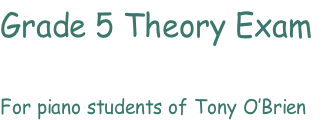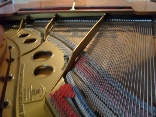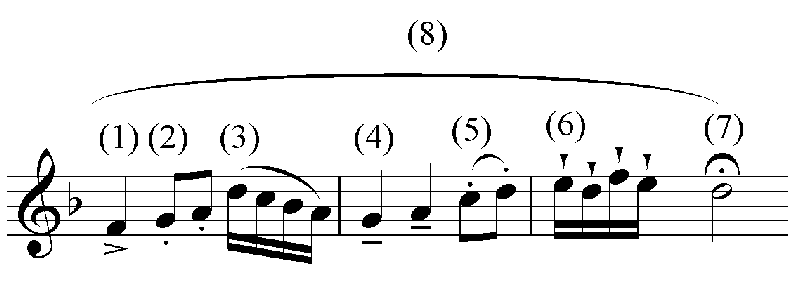(1) “Accent” - sudden sharp,heavy emphasis
(2) “Staccato” - detached,dry
(3) “Slur” - notes within slur to be played “legato” - smoothly with connect tone-
with lift on final note of slur
(4) “Tenuto” - hold onto tone/sound - opposite to staccato
(5) Favourite of G5 examiners indicates a longer sound than “normal” staccato is
required
(6)”Staccatissimo” (in modern usage) - extreme staccato, plays notes as briefly as
possible
(7) “Fermata” - commonly called a “pause” - indicates to continue the sound longer
than indicated by the note value at the discretion of the performer
(8) “Phrase mark” - indicates a group of musically related notes within the phrase,or
the whole phrase, suggesting how the music should flow from one end to the other
(1) “Down bow”
(2) “Up bow” - notes within slur to be played in one bow
(3) “Open string” - note to played on open E string
(4) “Pizzicato” - pluck strings with fingers rather than bow
(5) “(con) arco” - “with the bow” resume bowing notes after a period after playing
“pizzicato” “con legno” means “with wood” and is an instruction to play the notes
with the wood of the bow rather than the hair!
(6)”Harmonic” - play the note as a harmonic note.
This piece was written for violin and to know (3) was an “open string” and (6) was
an “harmonic” direction you need to know the tunings of the violin strings.
Here’s the tuning of strings complete string family, written from the lowest pitched
string upwards:-
Violin - G,D,A,E - in 5ths starting with G below middle C
Viola - C,G,D,A - in 5ths a 5th below the violin
Cello - C,G,D,A - in 5ths an octave below the viola
Double bass - E,A,D,G - in 4ths starting at E1
Guitar - E,A,D,G,B,E - mostly in 4ths, one 3rd starting at E2
This is strictly a “rhythm” question but is included here for convenience and because
questions on this aspect are always presented in the “general knowledge” question
4.
Well just as you can “dot” any note value to increase its note duration by half
as much again, you can “double dot” any note value to further increase its duration
by another “half as much again” - i.e. by another quarter . So a double dotted note
has “one and three quarters” the duration of the written note. Double dotted crotchets
are surprisingly common - you’ve probably played loads but never overlooked the notation.
You can “triple dot” - meaning you get a note one and seven eighths the duration
of the written note.




